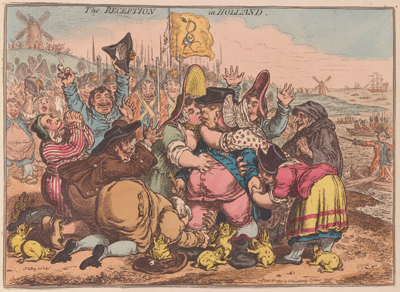The Reception in Holland
This is a case of premature celebration prompted perhaps by the wishful thinking of members of the Pitt administration for whom Gillray had begun to work in November of 1797. It shows William V, the Prince of Orange and Stadtholder of the Netherlands, returning to the homeland from which he had been ousted by the French-assisted Batavian Revolution. There he is surrounded by a bevy of (mostly) women giving him a rock-star's welcome. Behind him and stretching up to the windmill identifying this as Holland are further crowds of jubilant Dutch, both male and female, including Dutch soldiers. One of them carries a version of the Den Haag coat of arms with a stork and snake which may be intended to suggest this is the beach at Scheveningen from which the Stadtholder set off to England on January 18, 1795, and to which he now returns in triumph. At his feet are a bunch of fawning frogs, in this case probably representing Dutch lowlanders, not the French. Meanwhile, British troops are landing unopposed.

© Beinecke Rare Book and Manuscript Library, Yale University
The only problem with this picture is that it never happened. The lethargic and generally despised Stadtholder never returned to Holland. As Robin Reily remarks: "Comfortably installed at [Hampton Court Palace] he was more interested in the conquest of servant girls than in any effort to repossess himself of his country." (371) It was his son, the "Hereditary Prince" who accompanied the British and Russian troops as they invaded Holland and tried to reassert Orangist control. And in Scheveningen, as in most of inland Holland, there was no celebration at all but, in fact, active resistance from the Dutch Batavians even before the French came to their assistance.
But though the print was ultimately proven wrong, Gillray may perhaps be forgiven for thinking that it might have been representative of the outcome. The Anglo-Russian invasion of Holland began on August 27, not quite two weeks before Gillray's print. The advance reconnaisance by British intelligence operatives all suggested that Dutch allegiance to the French was only superficial, and that, as Simon Schama writes,
Once the Orange standard had been raised, . . . the Batavian army would go over to the forces of the Coalition to the last man and that its Republic would collapse under the barest pressure. (391)
At first, that intelligence appeared accurate. The British forces gained an immediate success at Callantsoog, when the outnumbered Batavian fleet avoided a fight and allowed the British troops to disembark unopposed and capture the fortresses at Den Helder. The sight of Orange flags flying so quickly above the forts led in turn to a mutiny within the Batavian fleet, where Orangist support was still strong, and to the easy capture of 632 guns and 3700 men on August 30.
These victories were duly trumpeted in the London newspapers and it was not just Gillray who anticipated the kind of celebration we see in The Reception in Holland. But the expected collapse, the welcoming crowds did not follow these initial victories. In October, well after Gillray's print appeared, it had become clear that the support for the Orangist cause had been vastly overestimated. And by November 19, the British had surrendered and were on their way home.
Sources and Reading
- Commentary from the British Museum on The Reception in Holland.
- "William V, Prince of Orange," Wikipedia
- "Anglo-Russian invasion of Holland," Wikipedia
- "Coat of arms of The Hague," Wikipedia
- "Origin of Froggy," Word Histories
- Robin Reilly, William Pitt the Younger, New York, 1979.
- Simon Schama, Patriots and Liberators: Revolution in the Netherlands 1780 - 1813, London, 1992
- Thomas Wright and R.H. Evans, Historical and Descriptive Account of the Caricatures of James Gillray #247
- Thomas Wright and R.H. Evans, Historical and Descriptive Account of the Caricatures of James Gillray #247.
- Thomas Wright and Joseph Grego, The Works of James Gillray, the Caricaturist; With the History of His Life and Times p. 260
Comments & Corrections
NOTE: Comments and/or corrections are always appreciated. To make that easier, I have included a form below that you can use. I promise never to share any of the info provided without your express permission.